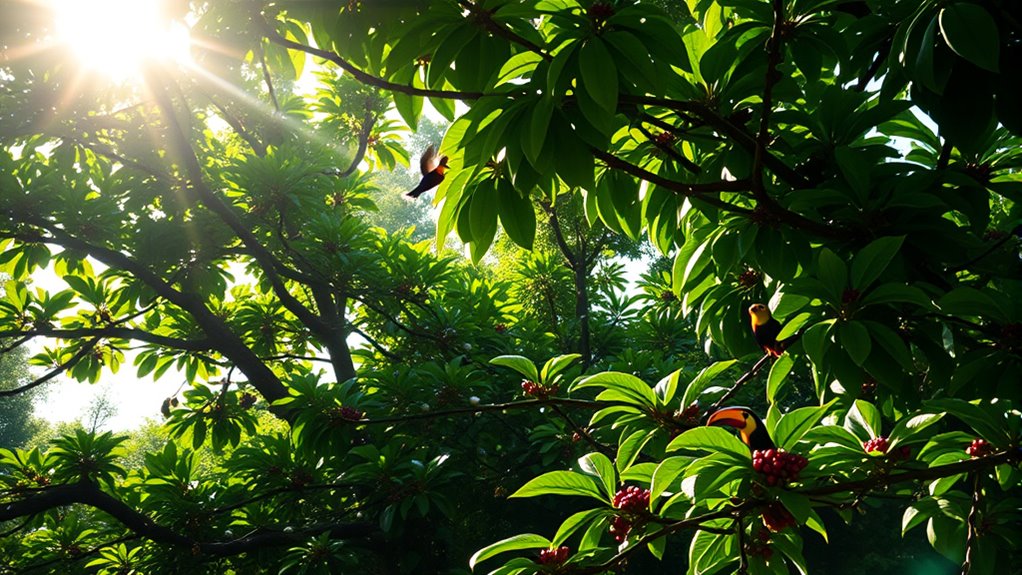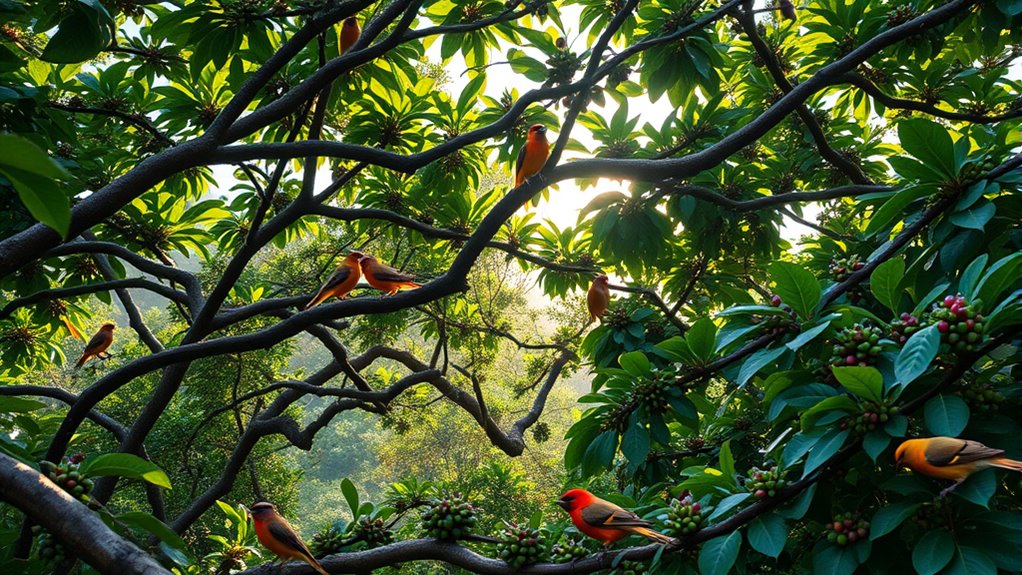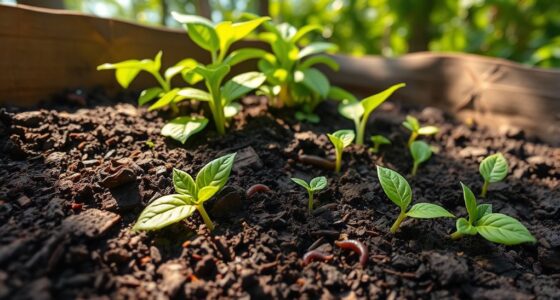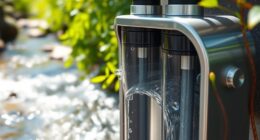Biodiversity on coffee farms, including birds, bees, and shade trees, boosts ecosystem health and crop yields. Shade trees provide shelter and food for wildlife, supporting beneficial insects and pest control. Bees pollinate coffee flowers, improving bean quality, while birds help manage pest populations naturally. By creating diverse habitats, you make your farm more resilient and sustainable. Keep exploring how these natural allies can enhance your coffee farming practices for a healthier environment.
Key Takeaways
- Shade trees create habitats that attract and support birds and bees, enhancing biodiversity on coffee farms.
- Diverse flora and fauna promote natural pest control, reducing chemical use and supporting ecosystem health.
- Pollinator-friendly plants increase bee populations, improving coffee pollination and crop yields.
- Birds and beneficial insects help control pests like coffee borer beetles naturally, boosting farm resilience.
- Maintaining biodiversity ensures long-term ecosystem stability, benefiting coffee quality and environmental sustainability.

Coffee farms can be rich habitats for biodiversity when managed thoughtfully. By adopting practices that support local ecosystems, you not only enhance the health of your coffee plants but also create a thriving environment for birds, bees, and other wildlife. One effective way to do this is by establishing pollinator habitats within your farm. These habitats provide essential resources like nectar and pollen, attracting bees and other pollinators that play a crucial role in the pollination process. When pollinators flourish, your coffee plants benefit from increased fruit set and better quality beans. Creating diverse flowering plants alongside your coffee crops ensures that pollinators can find food throughout the year, boosting their populations and resilience against environmental stresses.
In addition to supporting pollinators, integrating natural pest control strategies is essential for maintaining a healthy farm ecosystem. Instead of relying heavily on chemical pesticides, you can encourage beneficial insects and animals to keep pest populations in check. For instance, planting shade trees and maintaining diverse vegetation attract predatory insects and birds that prey on coffee pests like the coffee borer beetle or aphids. Birds, in particular, are excellent pest controllers—they hunt insects and help reduce the need for chemical interventions. By fostering habitats that attract these natural predators, you reduce your farm’s chemical footprint and promote a more sustainable, balanced ecosystem.
Shade trees play a fundamental role in creating a biodiverse coffee farm. These trees provide shelter and food for a variety of wildlife, including pollinators and pest predators. They also help regulate temperature and moisture levels, which benefits the coffee plants themselves. When you carefully select and manage shade trees, you create a microhabitat that encourages biodiversity, making your farm more resilient to pests and diseases. Moreover, shade trees can serve as corridors that connect different wildlife populations, supporting larger ecosystems that benefit your farm in the long run. Additionally, noise levels of modern heat pumps demonstrate how technological advancements can support sustainability efforts through quieter operation and reduced environmental impact.
Frequently Asked Questions
How Does Shade Tree Diversity Impact Coffee Flavor?
Diverse shade trees enhance coffee flavor by providing a balanced environment that promotes healthy bean development. These shade tree benefits include moderating temperature, reducing pests, and encouraging beneficial insects, all of which contribute to flavor enhancement. When you maintain a variety of shade trees, you create a more resilient ecosystem that produces beans with richer, more complex tastes, making your coffee more appealing and unique.
What Specific Bird Species Benefit Most From Coffee Farm Habitats?
Did you know that shade-grown coffee farms support over 300 bird species? You’ll notice that migratory birds, like warblers and tanagers, benefit most, especially during migration seasons. These habitats reduce nest predation by providing cover and food sources. By maintaining diverse shade trees, you help preserve these essential species, ensuring their survival and enriching the farm’s ecosystem. Your support makes a real difference for migratory bird conservation.
Can Shade-Grown Coffee Production Increase Local Water Quality?
Yes, shade-grown coffee can improve local water quality by reducing soil erosion and pesticide runoff. The shade trees help stabilize the soil, preventing erosion that can carry pollutants into water sources. Additionally, shade trees often require fewer pesticides, decreasing chemical contamination. By maintaining healthier soil and reducing chemical use, you contribute to cleaner water, benefiting both ecosystems and your community’s health.
How Do Bee Populations on Coffee Farms Influence Crop Yields?
You’ll see that healthy bee populations boost coffee crop yields through effective pollination services, ensuring more flowers are fertilized and produce cherries. Bees also help control pests naturally, reducing the need for chemical interventions. By maintaining bee-friendly habitats on your farm, you support pollination and pest control efforts, leading to healthier plants and better harvests. Protecting bees is essential for sustainable coffee production and overall farm productivity.
Are There Certifications That Promote Biodiversity-Friendly Coffee Farming?
Did you know that over 30 certifications promote biodiversity-friendly coffee farming? Certification standards, like Rainforest Alliance and Bird Friendly, focus on biodiversity incentives to protect ecosystems. These programs encourage practices that support wildlife, shade trees, and pollinator health. By choosing certified coffee, you help sustain biodiversity, ensuring healthier farms and ecosystems. Your choices can make a real difference in conserving crucial habitats for birds, bees, and other wildlife.
Conclusion
So, next time you sip that perfect cup of coffee, remember you’re also sipping on a tiny rainforest full of birds, bees, and shade trees. Clearly, the secret to great coffee isn’t just about beans—it’s about saving ecosystems, too. But hey, who needs biodiversity when you’ve got a fresh brew, right? Just keep enjoying your coffee while ignoring the tiny life forms that make it all possible. Cheers to biodiversity—virtually invisible, but totally essential!









